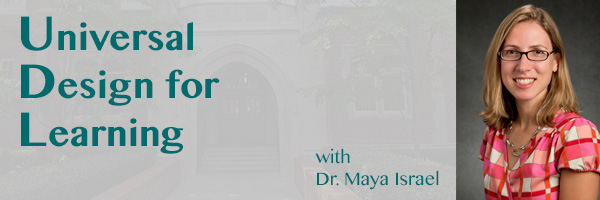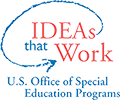Universal Design for Learning

Sep. 3, 2013
Universal Design for Learning (UDL) is an instructional framework for curriculum development and planning born out of architecture and universal design of spaces and environments for inherent accessibility. UDL, according to Maya Israel (University of Illinois, Urbana-Champaign), is a way of building and delivering content proactively to ensure that we meet the needs of all learners, particularly those who have disabilities or who struggle. Maya’s research and teaching focus on meaningful engagement and learning of students with disabilities, with special emphasis in STEM (Science, Technology, Engineering, and Mathematics). She is also the lead author of the UDL Innovation Configuration developed for use in the CEEDAR Center’s technical assistance. The UDL Innovation Configuration will soon be available on our website. This product will be a useful tool for teacher and leader educators as well as school leaders and professional development providers to increase and sustain the use of UDL principles in schools.
When we asked Maya about common misconceptions of UDL, one of the first we discussed was that UDL and technology are one in the same. She described UDL as an overarching framework to plan and deliver instruction in accessible ways and pointed to various technologies that could be used as a tool to carry out universally designed instruction. Technology should be used when it is available, but it must be used purposefully and flexibly to meet students’ needs. The technologies, therefore, support UDL implementation among other instructional practices.
In Maya’s own practice as a teacher educator, she views the following steps as important to building knowledge and skills related to UDL:
1. Teach the theory behind UDL, including access, use of flexible materials, and curricular design and selection
2. Provide practical examples of application with opportunities to experience multiples means of representation, action and expression, and engagement in multiple contexts
3. Provide coaching and support through discussion and assignments for documenting and processing observations during field experiences
4. Facilitate opportunities to practice, apply, and analyze UDL implementation in authentic settings, focusing on what curriculum looks like, how well it aligns with UDL principles, and how to adapt it if necessary
Maya admits that implementation is challenging, but should be integrated as seamlessly as possible and not simply added on to current school reform efforts. This is critical considering the widespread implementation of Response to Intervention and Positive Behavior Interventions and Supports as well as a recent push to include UDL in the language of the reauthorization of the Elementary and Secondary Education Act.
As we all work to improve students’ college and career readiness upon graduation, the following considerations should be made:
• There is promising research to support UDL as a good instructional framework for all learners, and students with disabilities in particular
• UDL requires systems change thinking including resource availability, implementation support, and buy-in
• Teacher and leader educators should ensure that UDL principles are covered in theory and practice in preparation programs and integrate them in their own pedagogy
• School leaders should structure collaborative planning time for teachers and other professionals and provide access to appropriate resources technologies
• School leaders should be mindful in selecting curricula to be sure that they are truly “UDL-friendly” and will lend themselves to planning using a UDL framework. Even when the curriculum aligns well with UDL, implementation occurs when teachers plan and teach with the UDL framework, not only relying on the “formal curriculum.”
• School teachers should be aware that this shift in thinking may initially require more time for planning, but it offers students more flexibility and accessibility that results in increased learning.


